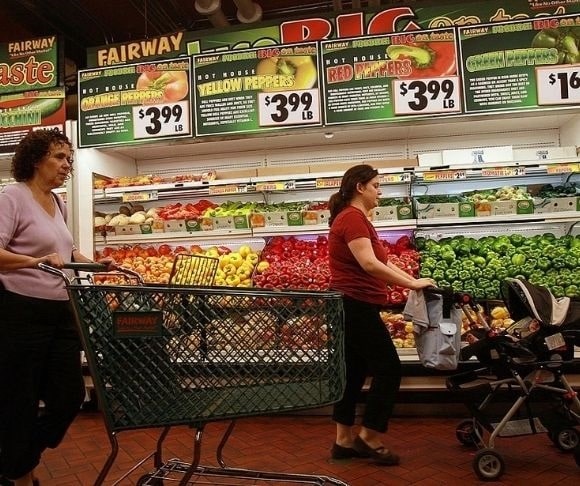Is inflation still transitory? The Bureau of Labor Statistics (BLS) published the latest consumer price index (CPI) numbers for September, and the data suggested that the claims made by the Federal Reserve and the White House that inflation is transitory might be hogwash. From skyrocketing food prices to advancing energy costs, inflation in the United States does not appear to be subsiding. But the smartest men and women in Washington contend that red-hot inflation will be doused someway and somehow, much like when Principal Skinner from The Simpsons says to himself, “Am I so out of touch? No. It’s the children who are wrong.”
Bidenflation Stays Hot in September
 The U.S. annual inflation rate surged to a 13-year high of 5.4% in September, slightly higher than economists’ expectations of 5.3%. The core inflation rate, which puts the kibosh on the volatile food and energy sectors, remained unchanged at 4%. On a monthly basis, the CPI rose 0.4%, slightly higher than the median estimate of 0.3%, and the core CPI matched market forecasts of 0.2%.
The U.S. annual inflation rate surged to a 13-year high of 5.4% in September, slightly higher than economists’ expectations of 5.3%. The core inflation rate, which puts the kibosh on the volatile food and energy sectors, remained unchanged at 4%. On a monthly basis, the CPI rose 0.4%, slightly higher than the median estimate of 0.3%, and the core CPI matched market forecasts of 0.2%.
Last month, everything required a few more dollars in your pocket compared to the same time last year, whether it was buying your favorite vegan proteins at the supermarket or fueling up your Soviet-era Lada automobile.
Food advanced 4.6%, with food at home climbing 4.5% and dining out rising 4.7%. The six main grocery store food group indexes increased, led by meats, eggs, fish, and poultry. Fruits and vegetables, dairy, non-alcoholic beverages, and baked goods ate away your purchasing power.
The energy index spiked 24.8% over the last 12 months as all energy commodities surged. The primary growth was concentrated in gasoline (42.1%), natural gas (20.6%), and electricity (5.2%).
Shelter picked up 3.2%, transportation services tacked on 4.4%, and apparel gained 3.4% in the 12 months ending in September. Suffice it to say, when combing through the BLS numbers, every single category was higher year-over-year. Even on a month-over-month basis, only four components in the basket of goods declined: apparel (-1.1%), used cars and trucks (-0.7%), transportation services (-0.5%), and medical care services (-0.1%).
Market analysts contend that one of the biggest revelations in the monthly snapshot of the U.S. economy was the inflation for rent, which was the highest since the 2006 housing bubble. This has many industry observers anticipating that rents will keep inflation firmer for many more months.
Who You Going to Believe?
In the classic Marx Bros. film, Duck Soup, Chico Marx asks, “Who are you going to believe, me or your own eyes?” This line can best apply to how the Swamp is trying to convince Americans that inflation remains transitory, despite everything that Americans see with their own eyes.
“This is one more data point to say, ‘Fed, your trying to convince us that inflation is transitory is just not believable,’” said Bob Doll, chief investment officer at Crossmark Global Investments. “If you know anybody who doesn’t have to live somewhere, doesn’t eat any food and doesn’t use energy, then inflation is maybe not a particular problem. But come on.”
Indeed, it has been quite a year for these policymakers who first insisted that higher prices would not happen to now warn that sizzling inflation will be the new normal until next year. And the public is ostensibly not buying what these esteemed bureaucrats are selling anymore.

(Photo by Spencer Platt/Getty Images)
The Federal Reserve Bank of New York released its latest monthly Survey of Consumer Expectations, revealing that U.S. households now think inflation will jump to 5.3% in a year and 4.2% in the next three years. Is this why some of the establishment’s power brokers call transitory a “dirty word”?
Federal Reserve Bank of Atlanta President Raphael Bostic recently told the Peterson Institute for International Economics (PIIE) in a prepared speech: “This has become a swear word to my staff and me over the past few months. Say ‘transitory’ and you have to put a dollar in the jar. My issue is not with the meaning of the word, but with using it to describe current inflation dynamics.”
Other central bankers are bucking what the official line is inside the Eccles Building. St. Louis Fed President James Bullard posited that inflation could approach 3% next year, higher than the institution’s wider forecast of 2.3%. What about the White House? It is more than likely that the administration will say that nobody saw this coming, despite the myriad of reports suggesting that inflation was inevitable.
Is Relief on the Way?
The shipping container crisis is not abating. The energy crisis is beginning to escalate ahead of Old Man Winter’s arrival. Producer prices are still smoking. Most hard and soft commodities are trending at or near all-time highs. But there is hope. The U.S. Department of Agriculture (USDA) released its World Agricultural Supply and Demand Estimates (WASDE) report, spotlighting that corn and soybean output is increasing, so there might be some modest relief at the supermarket next year. Until then, consumers will need to store their nuts – winter is coming!
~ Read more from Andrew Moran.




